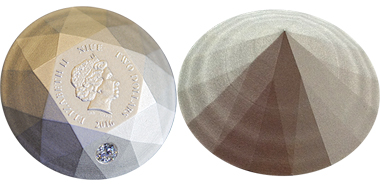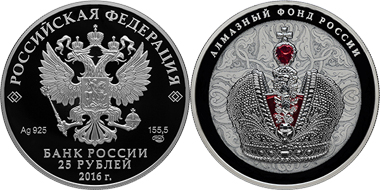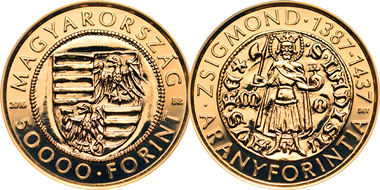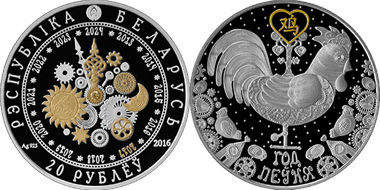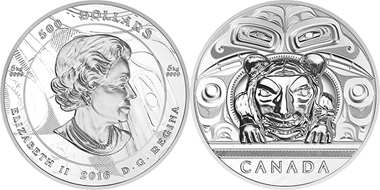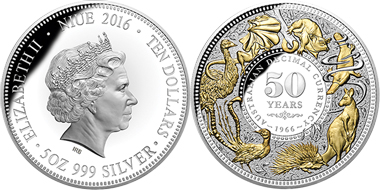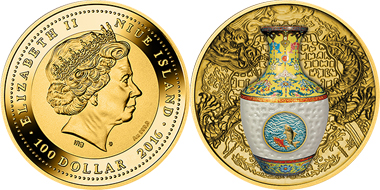October 5, 2017 – “Coin Constellation” is the only international contest of commemorative coins held within the territory of Russia. Coins submitted by the national banks, mints and coin distributing companies from all over the world participate in the contest.
The following coins were honored:
Helvetic Mint, Switzerland, is the winner in the category “Unique Concept”.
Unique Concept
The winner is “3D Diamond” coin struck at Helvetic Mint (Switzerland). It is the first coin in the world in the shape of a diamond out of a whole piece of silver with an insert of 0.1-carat diamond. According to the manufacturers, the peculiarity of the coin is in the unique minting. The coin has 32 planes, 1 culette (with the image of Queen Elizabeth II) and 24 bottom facets – just like a diamond. In one of the bottom facets, there is an insert of a real diamond.
“Tamdakht Meteorite” coin submitted by Coin Invest Trust (Lichtenstein) occupied the second place. This coin of pure silver has an insert of meteorite. On the obverse of the coin, there is a through hole, and on the reverse there is an image of the imprint of the meteorite that fell in Morocco on December 20, 2008, with a detailed reproduction of the crater cracks.
“Time” coin struck at the Austrian Mint received the third place. It is a silver coin with niobium; a clock face and 12 Zodiac signs are depicted on it. On the coin reverse, there is a sundial, a moon dial, a sandglass, an electronic watch; there is also a stylized depiction of nanoseconds. The coin narrates how the time measuring devices changed over the course of history.
Russia was the winner in the category “Successful Artistic Solution”.
Successful Artistic Solution
The winner in this category is “Great Imperial Crown” coin (special edition). The Central Bank of Russia and the Saint Petersburg Mint were awarded for the coin.
“Christmas Battles” coin issued by the Bank of Latvia received the second place. A stylized sun – the sign of the Battalion of the Latvian Shooters – is depicted on the coin obverse, with a red field, eight interrupted beams and a sword against the background of a group of Latvian shooters in the center. On the reverse, there are snowflakes and a bullet hole. The coin was issued in memory of the heroes of the Christmas battles (January 5-11, 1917). The technological execution of the coin struck at the Lithuanian Mint is interesting.
“Northern Lights in the Moonlight” coin struck at the Royal Canadian Mint received the third prize. This silver coin has coloured coating glowing in the dark. The reverse composition reconstructs the beauty of a winter night in Auyuittuq National Canadian Park. Tor vertical rock rises in the background, and two howling wolves from Baffin Island are against the background of a frozen river. In order to see the lighting effect in the best possible way, the coin should be observed in the dark after having been exposed to light for 30-60 seconds. The soft glowing of a moon night in a snow-covered landscape is reproduced on the coin with adding shades of green, yellow, pink and orange colours of various intensity.
Latvia was the winner in the category “Original Technology”.
Original Technology
“The Earth” coin issued by the Bank of Latvia received the first place. A brand new material – perlucor – was applied in the coin minting. A ring was made of it; it is surrounded with a silver outer ring. In the coin center, there is a round image of the Earth (of silver) with a geophysical world map in colour.
“Oyster 5thAnniversary” coin submitted by NumisCollect (the Netherlands) received the second award. It is a silver coin produced in the shape of an oyster, it has a hologram and a pearl insert.
“The Canadian Coin Collection” 1-kilogram silver coin occupied the third position. On its obverse, there are images of more than 35 historical Canadian circulation coins, and all in the real original diameters. The coin has an ultrahigh relief.
Hungary was the winner in the category “Coin Classic”.
Coin Classic
“The Gold Florin of King Sigismund (1387-1437)” coin struck at the Hungarian Mint was the winner. The coat of arms of the first gold forint (florin) of Sigismund in depicted on the coin obverse. The reverse pictures Saint Laszlo I holding a battle-axe in his right hand and a sphere in his left. There is a Latin inscription on the coin, in English translation: “Sigismund, King of Hungary by the grace of God”.
The second prize was given to “The 150th Anniversary of Foundation of the Russian Historical Society” coin. “Nestor the Chronicler” work by Sculptor Mark Antokolskiy is depicted on this gold coin. The Central Bank of Russia and the Saint Petersburg Mint were awarded for the coin.
Dime “Mercury” struck at the United States Mint received the third prize.
Belarus was the winner in the category “Souvenir Coin”.
Souvenir Coin
The Jury named “The Year of the Rooster” coin submitted to the contest by the National Bank of the Republic of Belarus the best “Souvenir Coin”.
“500 Years Bavarian Purity Law” coin submitted by Coin Invest Trust (Lichtenstein) won the second place. The coin is made in the shape of a bottle cap. Coloured mugs with beer are depicted on the coin reverse.
The other winner of the second place was “Horseshoe” coin struck at the Kazakhstan Mint. The coin has a complicated shape reminding of a horseshoe in its contour. A gilded image of a horseshoe with a spiral enframed with inscription in English, the state language and Russian in the center, is located on the coin reverse. Moreover, the horseshoe tails are turned upwards. According to a popular belief, it is necessary so that luck would not flow out when it comes.
“Born to Be Happy (Welcome to the World)” coin submitted by the Mint of Poland received the third award. In the center of the coin reverse, there is a stylized image of a stork and a baby in cabbage. They are coloured. One should note that the coin is sold in a case made in the shape of cabbage.
Canada was the winner in the category “Silver Coin of the Year”.
Silver Coin of the Year
The 5-kilogram silver coin minted in Canada was chosen the silver coin of the year. It is called “Charles Edenshaw: Argillite Chest”. Argillite chest of Charles Edenshaw made in 1882 and ordered by Doctor Israel Wood Powell. A lion with human hair, nose and chin is depicted in the center of the chest. Two human hands enframe its face that looks as if it is getting out of a cave. In the background, there are images of Haida Indian tribe inhabiting the lands north-west of the Pacific Ocean famous for a special visual language. Charles Edenshaw was one of the most famous carvers of Haida.
“Italy of Arts – Sardinia” coin produced at the Italian Mint received the second place. A Sardinian bronze figurine of a warrior stored in Rome, at Luigi Pigorini National Museum of Prehistory and Ethnography is depicted on the coin reverse. In the background, there are “pintadera” round ceramic tiles from Nuragic Sardinia with a concentric geometric ornament. On the obverse, there is a Sardinian bronze figurine of a bowman preserved at the National Archaeological Museum in Cagliari. A geometric pattern of the railing of a Nuragic bronze boat is in the background.
“Mark Twain” coin struck at the United States Mint occupies the third position. A portrait of the writer with a smoking pipe in his hand is depicted on the obverse. Silhouettes of Huckleberry Finn and Jim floating along the Mississippi river are seen through the tobacco smoke. On the reverse, there are images of Mark Twain’s other characters.
Russia was the winner in the category “Gold Coin of the Year”.
Gold Coin of the Year
“Historic Architectural Ensemble of the Novodevichy Convent in Moscow” 1-kilogram coin struck at the Saint Petersburg Mint and submitted by the Central Bank of Russia was chosen the gold coin of the year. The coin shows the panorama of the convent and a copy of a miniature from the Illuminated Compiled Chronicle narrating the convent construction.
Two coins shared the second place. They are “French Excellence Van Cleef & Arpels” 1-kilogram coin produced at the Mint of Paris. The coin narrates images created at Van Cleef and Arpels Fashion House. In the center of the reverse, there is an insert specially created by Van Cleef and Arpels. The insert consists of two butterflies made of diamonds.
“Coin Dedicated to Physics” submitted by the Bank of Lithuania received the other award for the second place. This gold coin also weighs more than one kilogram. A stylized reflection of the laser light impulse is on its reverse.
“Flora In Art Masterpieces Contemporary Age” coin is on the third place. The coin was created at the Italian Mint. On the coin obverse, there is a bust of a lady with a floral crown on her head. It is a detail of Ettore de Maria Bergler’s “Floralia” fresco. On the reverse, there is a dancing female figure in a flower field with a floral garland. It is also a detail of “Floralia”.
Downies Coins Pty Ltd (Australia) was the winner in the category “Coin of the Year”.
Coin of the Year
In the opinion of the jury, “50 Years Australian Decimal Currency” submitted by Downies Coins Pty Ltd (Australia) became the coin of the year. Animals from the first decimal coins of 1966 are depicted on this coin. They were seven animals and birds from the emblematic fauna of Australia.
“Winged Isis” coin submitted by Numiartis (Germany) received the second prize. Pyramids, columns and Egyptian figures are depicted on one side of it. Winged Isis on a stone pedestal on the other side. The coin is interesting because of the application of Smartminting technology – there is gilding, a coloured image and antique finishing.
Two coins shared the third place. The first is “The World through the Eyes of Children” issued by the National Bank of the Republic of Belarus. The coin was made according to sketches chosen as a result of a children’s drawings competition held by the National Bank. In the center of the coin reverse, there is an image of a boy and a girl with wooden birds in their hands.
The other is “250th Anniversary of the Foundation of the Warsaw Mint” struck at the Mint of Poland and submitted by Narodowy Bank Poland.
Special prize by the Organizing Committee
The Special Prize was given to Numiscom GmbH & Co. KG (Germany) for an exceptionally lucky combination of technological innovations and artistic design of coins.
Prize “For the contribution to the development of commemorative coins market”
This year, Georgy I. Luntovskiy, President of Association “Russia”, Member of the Board of Directors of the Bank of Russia received the prize “For the contribution to the development of commemorative coins market”.
Monnaie de Paris also received the prize “For the contribution to the development of commemorative coins market” for innovative stylistic interpretation of the coin classics.
Poland was the winner in the category “People’s Choice Award”.
People’s Choice Award
According to the results of voting at www.Gold10.ru, “Chinese Porcelain Vase Qing Dynasty” silver coin (the Mint of Poland) received the People’s Choice Award.
There were totally over 13000 votes for the coins submitted to the contest. “Chinese Porcelain Vase Qing Dynasty” coin received the average score of 8,23 points out of 10 that enabled it to win in this category.
The winning coins were determined by absentee voting of the members of the International Expert Jury based on coin images and descriptions submitted by the participants. In the Competition Jury, there are specialists from well-known world museums and auction houses, representatives of numismatic associations and specialized editions about coins from different countries.
The organizer of “Coin Constellation” is Water Mark Publishing House, publisher of The Gold Chervonets Magazine and the organizer of the International Coin Conference and Exhibition.
For more information on past competitions, please click here.
Additional details of the conference and exhibition can be found at the COINS 2017 website.



